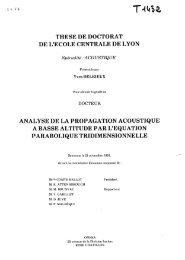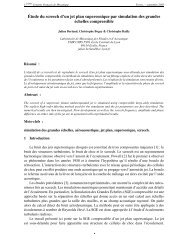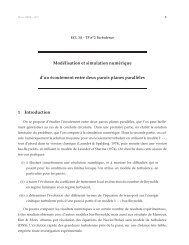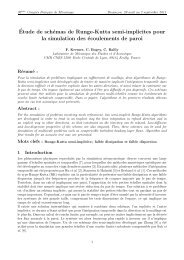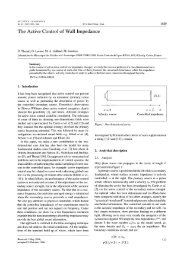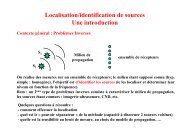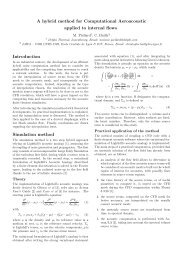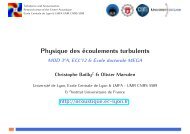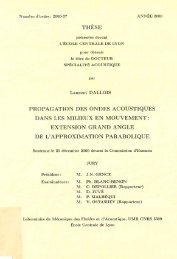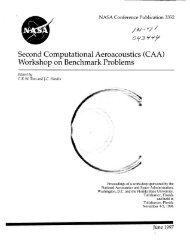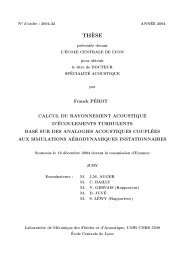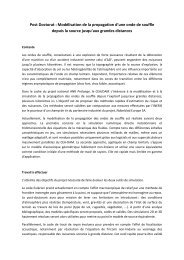On the radiated noise computed by large-eddy simulation
On the radiated noise computed by large-eddy simulation
On the radiated noise computed by large-eddy simulation
You also want an ePaper? Increase the reach of your titles
YUMPU automatically turns print PDFs into web optimized ePapers that Google loves.
Phys. Fluids, Vol. 13, No. 2, February 2001 <strong>On</strong> <strong>the</strong> <strong>radiated</strong> <strong>noise</strong> <strong>computed</strong> <strong>by</strong> <strong>large</strong>-<strong>eddy</strong> <strong>simulation</strong><br />
FIG. 17. Acoustic intensity ratio I/I LES <strong>computed</strong> from Liu’s model<br />
for all <strong>simulation</strong>s: Filtered DNS ; case 1 and case 2 ; case 3, case 4 and<br />
case 5 .<br />
prove <strong>the</strong> prediction of <strong>the</strong> location of <strong>the</strong> peak of acoustic<br />
spectrum with respect to DNS results. LES have been performed<br />
using a spectral <strong>eddy</strong>-viscosity model. The comparison<br />
between filtered DNS and LES led to small discrepancies<br />
when dealing with acoustic spectra. This is especially due to<br />
<strong>the</strong> difference between <strong>the</strong> filter kernel used for a priori tests<br />
and <strong>the</strong> effective filter of <strong>the</strong> a posteriori tests. As all <strong>the</strong>oretical<br />
models are based on infinite Reynolds number turbulent<br />
flow, <strong>the</strong> extension to LES in <strong>the</strong> vanishing viscosity<br />
case performed on several grids shows that <strong>the</strong>se models are<br />
recovered only if <strong>the</strong> inertial kinetic-energy range is <strong>large</strong><br />
enough. In all cases <strong>the</strong> parametrization give suitable and<br />
consistent results: <strong>the</strong> model introduced a correction to <strong>the</strong><br />
acoustic intensity which depends on <strong>the</strong> computational grid<br />
and yields a shift of <strong>the</strong> peak of acoustic toward <strong>large</strong>r frequencies<br />
for all considered cases.<br />
1 H. S. Ribner, ‘‘Quadrupole correlations governing <strong>the</strong> pattern of jet<br />
<strong>noise</strong>,’’ J. Fluid Mech. 38, 11969.<br />
2 M. E. Goldstein and B. Rosenbaum, ‘‘Effects of anisotropic turbulence on<br />
aerodynamic <strong>noise</strong>,’’ J. Acoust. Soc. Am. 54, 630 1973.<br />
3 W. Béchara, P Lafon, C. Bailly, and S. Candel, ‘‘Application of a k<br />
model to <strong>the</strong> prediction of <strong>noise</strong> for simple and coaxial free jets,’’ J.<br />
Acoust. Soc. Am. 97, 3518 1995.<br />
4 C. K. W. Tam, ‘‘Computational aeroacoustics: Issues and methods,’’<br />
AIAA J. 33, 17881995.<br />
5 S. K. Lele, ‘‘Computationnal aeroacoustics: A review,’’ in AIAA Paper<br />
97-0018 1997.<br />
6 J. Freund, T. Colonius, and K. Mohseni, ‘‘Acoustic sources in a turbulent<br />
jet: A direct numerical <strong>simulation</strong>,’’ in AIAA Paper 99-1858 1999.<br />
7 F. Bastin, P. Lafon, and S. Candel, ‘‘Computation of jet mixing <strong>noise</strong> due<br />
to coherent structures: The plane jet case,’’ J. Fluid Mech. 335, 261<br />
1997.<br />
8 C. Bailly, S. Candel, and P. Lafon, ‘‘Prediction of supersonic jet <strong>noise</strong><br />
from a statistical acoustic model and a compressible turbulence closure,’’<br />
J. Sound Vib. 194, 2191996.<br />
9 C. Bailly, P. Lafon, and S. Candel, ‘‘Subsonic and supersonic jet <strong>noise</strong><br />
prediction from statistical source models,’’ AIAA J. 35, 16881997.<br />
10 A. Witkowska, D. Juvé, and J. G. Brasseur, ‘‘Numerical study of <strong>noise</strong><br />
from isotropic turbulence,’’ J. Comput. Acoust. 5, 317 1997.<br />
11 E. Manoha, B. Troff, and P. Sagaut, ‘‘Trailing edge <strong>noise</strong> prediction using<br />
<strong>large</strong>-<strong>eddy</strong> <strong>simulation</strong> and acoustic analogy,’’ AIAA J. 38, 5752000.<br />
487<br />
12 M. J. Lighthill, ‘‘<strong>On</strong> sound generated aerodynamically. Part I: General<br />
<strong>the</strong>ory,’’ Proc. R. Soc. London, Ser. A 211, 5641952.<br />
13 M. J. Lighthill, ‘‘<strong>On</strong> sound generated aerodynamically. Part II: Turbulence<br />
as a source of sound,’’ Proc. R. Soc. London, Ser. A 222, 11954.<br />
14 G. M. Lilley, ‘‘The <strong>radiated</strong> <strong>noise</strong> from isotropic turbulence,’’ Theor.<br />
Comput. Fluid Dyn. 6, 281 1994.<br />
15 C. Bailly and D. Juvé, ‘‘A stochastic approach to compute subsonic <strong>noise</strong><br />
using linearized Euler’s equations,’’ in AIAA Paper 99-1872 1999.<br />
16 U. Piomelli, G. L. Streett, and S. Sarkar, ‘‘<strong>On</strong> <strong>the</strong> computation of sound <strong>by</strong><br />
<strong>large</strong>-<strong>eddy</strong> <strong>simulation</strong>s,’’ J. Eng. Math. 32, 2171997.<br />
17 C. Seror, P. Sagaut, C. Bailly, and D. Juvé, ‘‘Subgrid scale contribution to<br />
<strong>noise</strong> production in decaying isotropic turbulence,’’ AIAA J. 38, 1795<br />
2000.<br />
18 R. Rubinstein and Y. Zhou, ‘‘Characterization of sound <strong>radiated</strong> <strong>by</strong> unresolved<br />
scales of motion in computational aeroacoustics,’’ Technical Report<br />
99/39, ICASE 1999.<br />
19 I. Proudman, ‘‘The generation of sound <strong>by</strong> isotropic turbulence,’’ Proc. R.<br />
Soc. London, Ser. A 214, 119 1952.<br />
20 S. Sarkar and M. Y. Hussaini, ‘‘Computation of <strong>the</strong> sound generated <strong>by</strong><br />
isotropic turbulence,’’ Technical Report 93-74, ICASE 1993.<br />
21 D. G. Crighton, A. P. Dowling, J. E. Ffowcs Williams, M. Heckl, and F.<br />
G. Leppington, Modern Methods in Analytical Acoustics Springer Verlag,<br />
New York, 1992.<br />
22 P. Moin and K. Mahesh, ‘‘Direct Numerical Simulation: A tool in turbulence<br />
research,’’ Annu. Rev. Fluid Mech. 30, 539 1998.<br />
23 S. C. Crow, ‘‘Aerodynamic sound emission as a singular perturbation<br />
problem,’’ Stud. Appl. Math. 49, 211970.<br />
24 J. R. Ristorcelli, ‘‘A closure for <strong>the</strong> compressibility of <strong>the</strong> source terms in<br />
Lighthill’s acoustic analogy,’’ Technical Report 97-44, ICASE 1997.<br />
25 S. A. Orszag, ‘‘Numerical <strong>simulation</strong> of incompressible flows within<br />
simple boundaries: I. Galerkin spectral representations,’’ Stud. Appl.<br />
Math. 2, 293 1971.<br />
26 S. A. Orszag, ‘‘Numerical <strong>simulation</strong> of incompressible flows within<br />
simple boundaries: II. Accuracy,’’ J. Fluid Mech. 49, 751971.<br />
27 R. S. Rogallo and P. Moin, ‘‘Numerical <strong>simulation</strong> of turbulent flows,’’<br />
Annu. Rev. Fluid Mech. 16, 991984.<br />
28 G. Comte-Bellot and S. Corrsin, ‘‘The use of contraction to improve <strong>the</strong><br />
isotropy of grid-generated turbulence,’’ J. Fluid Mech. 25, 6571966.<br />
29 E. D. Siggia and G. S. Patterson, ‘‘Intermittency effects in a numerical<br />
<strong>simulation</strong> of stationarity three-dimensional turbulence,’’ J. Fluid Mech.<br />
86, 567 1978.<br />
30 Z.-S. She, E. Jackson, and S. A. Orszag, Statistical Aspect of Vortex Dynamics<br />
in Turbulence, New Perspectives in Turbulence Springer, Berlin,<br />
1991.<br />
31 M. R. Overholt and S. B. Pope, ‘‘A deterministic forcing scheme for direct<br />
numerical <strong>simulation</strong>s of turbulence,’’ Comput. Fluids 27, 111998.<br />
32 O. Métais and M. Lesieur, ‘‘Spectral <strong>large</strong>-<strong>eddy</strong> <strong>simulation</strong> of isotropic<br />
and stably stratified turbulence,’’ J. Fluid Mech. 256, 157 1992.<br />
33 W. K. Blake, Mechanics of Flow-Induced Sound and Vibration Academic,<br />
New York, 1986, Vol. 1.<br />
34 V. Eswaran and S. B. Pope, ‘‘An examination of forcing in direct numerical<br />
<strong>simulation</strong>s of turbulence,’’ Comput. Fluids 16, 2571988.<br />
35 A. Debussche, T. Dubois, and R. Temam, ‘‘The Nonlinear Galerkin<br />
Method: A multi-scale method applied to <strong>the</strong> <strong>simulation</strong> of homogeneous<br />
turbulent flows,’’ Technical Report 93/93, ICASE 1993.<br />
36 Y. Zhou and R. Rubinstein, ‘‘Sweeping and straining effects in sound<br />
generation <strong>by</strong> high Reynolds number isotropic turbulence,’’ Phys. Fluids<br />
8, 647 1996.<br />
37 G. M. Lilley, ‘‘The <strong>radiated</strong> <strong>noise</strong> from isotropic turbulence with applications<br />
to <strong>the</strong> <strong>the</strong>ory of jet <strong>noise</strong>,’’ J. Sound Vib. 190, 463 1996.<br />
38 J. Smagorinsky, ‘‘General circulation experiments with primitive equations.<br />
I: The basic experiment,’’ Mon. Wea<strong>the</strong>r Rev. 91, 991963.<br />
39 J. Bardina, J. H. Ferziger, and W. C. Reynolds, ‘‘Improved subgrid scale<br />
models for Large-Eddy Simulation,’’ in AIAA Paper 80-1357 1980.<br />
40 J. Bardina, J. H. Ferziger, and W. C. Reynolds, ‘‘Improved turbulence<br />
models based on Large-Eddy Simulation of homogeneous, incompressible,<br />
turbulent flows,’’ Technical Report TF-19, Thermosciences Division,<br />
Dept. Mechanical Engineering, Stanford University 1983.<br />
41 S. Liu, C. Meneveau, and J. Katz, ‘‘<strong>On</strong> <strong>the</strong> properties of similarity<br />
subgrid-scale models deduced from measurements in a turbulent jet,’’ J.<br />
Fluid Mech. 275, 831994.<br />
Downloaded 17 Mar 2003 to 156.18.39.49. Redistribution subject to AIP license or copyright, see http://ojps.aip.org/phf/phfcr.jsp



